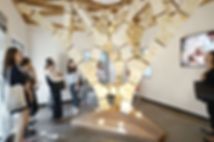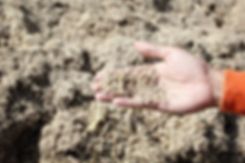Beyond Mining - Urban Growth
MycoTree is a spatial branching structure made out of load -bearing mycelium components. Its geometry was designed using 3D graphic statics, keeping the weak material in compression only. Its complex nodes were grown in digitally fabricated moulds.
Utilising only mycelium and bamboo, the structure represents a provocative vision of how we may move beyond the mining of our construction materials from the earth’s crust to their cultivation and urban growth; how achieving stability through geometry rather than through material strength opens up the possibility of using weaker materials structurally and safely; and, ultimately, how regenerative resources in combination with informed structural design have the potential to propose an alternative to established, structural materials for a more sustainable building industry.

Using polyhedral form and force
diagrams, it allows exploring and discovering efficient but expressive structural forms, going beyond the arch or vault in compression, such as the compression-only branching geometry of MycoTree.
Mycelium-based materials offer significant ecological advan tages on the one hand but comparably low structural strength on the other. When building with materials that are weak in tension and bending, good geometry is essential for maintaining equilibrium through contact only -that is, through compression. Funicular geometry has the advantage that stresses in it are very low. Development of engineered materials, such as concrete or steel, is largely focused on making these materials stronger, on increasing their allowable stress. However, achieving stability through geometry rather than through material strength opens up the possibility of using weak materials.
The structure’s geometry was designed using 3D graphic statics, a novel method developed by the Block Research Group at ETH Zürich that extends the traditional two dimensional structural design technique to fully spatial systems. Using polyhedral form and force diagrams, it allows exploring and discovering efficient but expressive structural forms, going beyond the arch or vault in compression, such as the compression-only branching geometry of MycoTree. Polyhedral by construction, without the need for optimisation, the structure’s complex nodes could be materialised using developable surfaces, which can be cut from sheet material.
Structural geometry for
“low strength"
materials




Credits:
Team / Authors
Sustainable Construction, Karlsruhe Institute of Technology, KIT Karlsruhe:
Karsten Schlesier, Felix Heisel, Dirk Hebel
Block Research Group, ETH Zürich:
Juney Lee, Matthias Rippmann, Tomás Méndez Echenagucia, Andrew Liew, Noelle Paulson,
Tom Van Mele, Philippe Block
Alternative Construction Materials, Future Cities Laboratory, Singapore-ETH Centre:
Nazanin Saeidi, Alireza Javadian, Adi Reza Nugroho, Robbi Zidna Ilman, Erlambang Adjidarma, Ronaldiaz Hartantyo, Dustin Fleck, Hokie Christian, Orion Tan, Sheng Yu, Kelly Cooper
Production partner
Mycotech, PT Miko Bahtera Nusantara, Indonesia
Sponsors
ETH Global
ETH Zürich, Department of Architecture
Karlsruhe Institute of Technology (KIT)
Future Cities Laboratory (FCL), Singapore-ETH Centre
© Block Research Group
© Juney Lee
© Juney Lee
© Carlina Teteris


